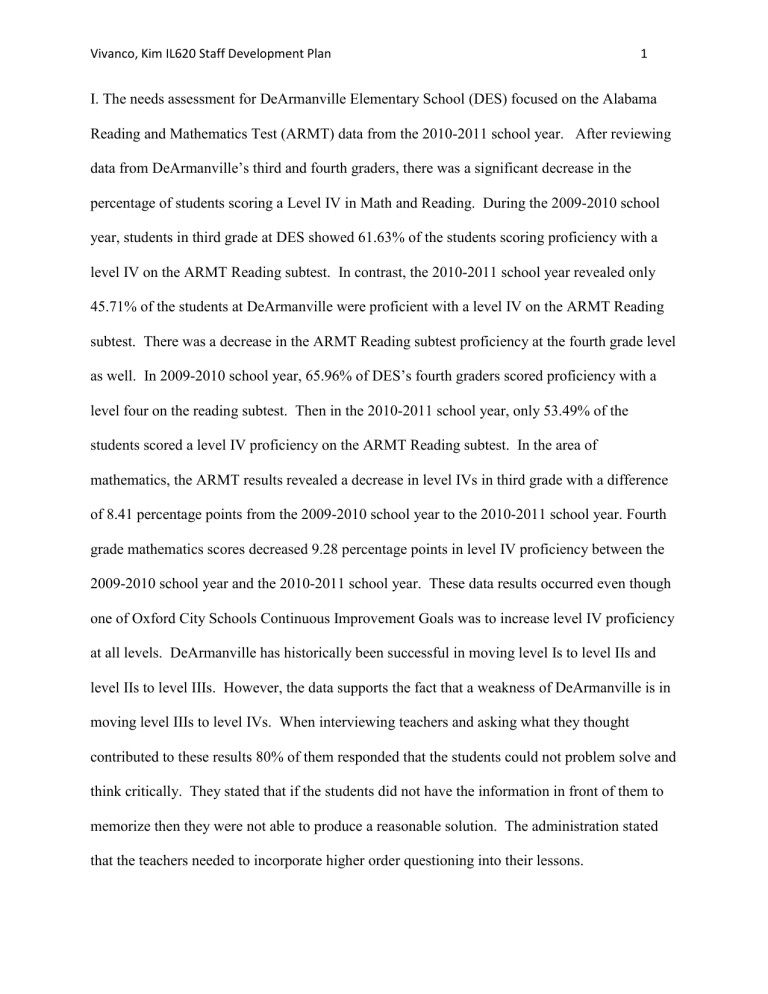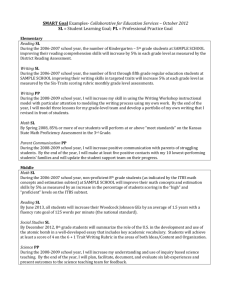Vivanco__Kim_Staff_Development_Plan

Vivanco, Kim IL620 Staff Development Plan 1
I. The needs assessment for DeArmanville Elementary School (DES) focused on the Alabama
Reading and Mathematics Test (ARMT) data from the 2010-2011 school year. After reviewing data from DeArmanville’s third and fourth graders, there was a significant decrease in the percentage of students scoring a Level IV in Math and Reading. During the 2009-2010 school year, students in third grade at DES showed 61.63% of the students scoring proficiency with a level IV on the ARMT Reading subtest. In contrast, the 2010-2011 school year revealed only
45.71% of the students at DeArmanville were proficient with a level IV on the ARMT Reading subtest. There was a decrease in the ARMT Reading subtest proficiency at the fourth grade level as well. In 2009-2010 school year, 65.96% of DES’s fourth graders scored proficiency with a level four on the reading subtest. Then in the 2010-2011 school year, only 53.49% of the students scored a level IV proficiency on the ARMT Reading subtest. In the area of mathematics, the ARMT results revealed a decrease in level IVs in third grade with a difference of 8.41 percentage points from the 2009-2010 school year to the 2010-2011 school year. Fourth grade mathematics scores decreased 9.28 percentage points in level IV proficiency between the
2009-2010 school year and the 2010-2011 school year. These data results occurred even though one of Oxford City Schools Continuous Improvement Goals was to increase level IV proficiency at all levels. DeArmanville has historically been successful in moving level Is to level IIs and level IIs to level IIIs. However, the data supports the fact that a weakness of DeArmanville is in moving level IIIs to level IVs. When interviewing teachers and asking what they thought contributed to these results 80% of them responded that the students could not problem solve and think critically. They stated that if the students did not have the information in front of them to memorize then they were not able to produce a reasonable solution. The administration stated that the teachers needed to incorporate higher order questioning into their lessons.
Vivanco, Kim IL620 Staff Development Plan 2
II. Since DES is an elementary school, I was able to conduct walkthroughs that focused on all students, special education students, and English Language Learners. During my walkthroughs at DES, I observed the teachers utilizing various engagement strategies for all students. When the engagement was observed it was very affirming, Oxford City Schools has maintained the CIP goal of 100% student engagement 100% of the time. Teachers were utilizing strategies such as: think pair share, turn and talk, four heads together, partner reading, exit slips, quick writes, etc.
The classrooms were organized in a way that was conducive to different groupings. For example, in one classroom the teacher had a pod of four desks pulled together. With two seats side by side and two seats directly in front of them, the teacher was having them to discuss with your face partner which would be the student in the front of them and discuss with their shoulder partner. In 70% of the classrooms observed, the teachers were pulling small groups based on their ability level. The lessons for the small group instruction seemed to be planned for each individual group. I got to stay in one classroom through two station rotations and the teacher somewhat differentiated the lesson for the students. One group was able to read the text with a partner and discuss whole group and the other group read the text chorally with the teachers voice included. However, I did note that other than the method of reading the text only one teacher in the second grade actually varied the level of the questioning brought to the comprehension discussion. The special education teacher was involved in co-teaching with the regular education teacher. The instruction was very explicit and offered multiple practice opportunities. I only observed the special education teacher twice during the observations.
There is only 12 identified special education students that attend DES. These students are serviced in the regular education classroom as much as possible. I did get to observe the special education teacher delivering an intervention lesson. She was utilizing a scientifically based research program and the group size was very small. I did note the use of technology in her
Vivanco, Kim IL620 Staff Development Plan 3 classroom. She was mostly working on word study with this group of students. However, there was a small comprehension discussion after the reading. She had made a power point presentation that she was projecting using an LCD projector. This power point focused on the vocabulary words that were in the story. The teacher had embedded some visuals for each vocabulary word. I thought this was a great strategy for increasing background knowledge for the special education students and the English Language Learners (ELL) in the small group. The
ELL students at DES are receiving sheltered instruction. The teachers at DES have received professional development in this area from Auburn University. DES also has a part time ELL teacher that does work with small groups of students based on their ACCESS proficiency levels.
During my observations of the math block, some of the classrooms were utilizing computers to attain extra practice on math computation. The teacher was monitoring the classroom and providing feedback to students. I did note that some of the students seemed to be working on computational skills that were below grade level. They were answering the problems quickly with few errors which told me that they needed to be placed at a higher level on the program. The other classrooms observed featured teachers using Alabama Math, Science, and Technology Initiative (AMSTI) modules. AMSTI lessons are very hands-on thus extremely engaging. However, the philosophy of AMSTI centers on the students exploring the concepts and building understanding. Most of the teachers were asking yes and no questions during the exploration time. The AMSTI classrooms that were conducting experiments were working with a partner. However, I would have liked to have seen them recording their findings in some way.
I think the students needed some type of accountability document. Most partners were very excited about the experiment but when I asked them to explain what they were doing they could not answer.
Vivanco, Kim IL620 Staff Development Plan 4
III. Based on my review of the available data and observations, I have developed a plan for addressing the needs of the teachers and students at DeArmanville Elementary School. In order to improve proficiency levels in the area of reading the second, third, and fourth grade teachers should maximize instructional time by construction comprehension stations. The stations might be in the form of literature circles. The students should have response journals, partner interview logs, question logs, or Q-Charts where they would have to respond to higher order thinking questions. To support these efforts, the Kindergarten and first grade teachers should utilize retell rubrics to foster the development of comprehension skills in the early grades. In addition second through fourth grade teachers should utilize open ended questions in class each week. A parent night would be helpful to give parents tips on asking quality questions. The district Bloom’s taxonomy bookmark would be a great tool to share with parents since it has question stems that promote critical thinking. Short video clips could be made of teachers utilizing the bookmarks to ask students questions could be added to the school website where parents could access models of teachers utilizing higher order questioning. Teachers should continue to use engagement strategies but extend the purpose further than management. When the students turn and talk the questions should become higher order resulting in critical thinking. In order to promote quality questioning, the teachers need to plan together and develop questions.
When focusing on increasing the level IV proficiency in the area of mathematics, the teachers should use quality questioning as an instructional strategy in order to check the depth understanding students have in mathematical problem solving. To support the students in being successful problem solvers, the teachers should continue to explicitly teach math vocabulary development. If the students aren’t able to identify certain mathematical terms, they will not be able to problem solve. One strategy for support math vocabulary would be to build a math word
Vivanco, Kim IL620 Staff Development Plan 5 wall with visuals. Parental support can be enhanced by providing a parent math night where parents learn the importance of fact fluency. The technology component (VMATH LIVE) can be accessed from home. Parents would benefit with a basic training session on utilizing the various reports that can be generated from the website. During the parent night, the teacher could let the parent know what levels on VMATH that the student should be using.
The ELL population showed a weakness in the area of writing on the ACCESS. DES has a district goal of increasing proficiency from 20% to 49% on the writing portion of the ACCESS.
In order to address the weakness in writing, the teacher should attend a writing workshop. The counselor at DES has been trained in ELL strategies. She would be a fabulous resource in setting expectations and ongoing training. The training should inform the teachers of what the
ELL students are expected to write on the ACCESS. In the classroom, the students should be asked to write in journals. A book study on Four Square Writing would also be beneficial to the faculty. The emphasis would be to help students develop stories through the use of graphic organizers. I also believe that the teacher should be trained to use reciprocal teaching with ELL students when giving a writing assignment. The teacher would first describe a writing assignment and then the students will have to explain the assignments to the teacher. This will help the teacher determine if the students understand the assignments or if language is a barrier.
The ELL teacher could hold parent workshops and invite the translator to attend the meetings.
The purpose of the workshop should be how to help your students write about their learning.
The parents could be encouraged to have their children keep a home journal where they write about events that happen in the home. The school could offer short video tips on the website that would help parents help their children practice writing in the home.
Vivanco, Kim IL620 Staff Development Plan 6
IV. I gained great insight from reviewing the Continuous Improvement Plan at DeArmanville
Elementary School. I was able to conduct observations and reflect on the Continuous
Improvement Plan and build a professional development plan that supports the goals that
DeArmanville Elementary School had developed. The largest insight that I am taking away from this experience is the huge connection between student data, observations, goals and professional development. The professional development that is offered at a school needs to support the needs of the school. In order to understand the needs of the school, one must study the data and visit the classrooms. Then, the data collected must be prioritized. Once the greatest needs are identified and the goals created, one must ask what will support look like. It might be professional development sessions, book studies, peer support, expert from inside the school, expert from outside the school etc. I think that ultimately teachers should be supported to lead their own learning walks and identify weaknesses that need to be supported in order for the school Continuous Improvement Goals to be satisfied. If teachers are a part of the goal setting process, they will have that vested ownership in using their time to problem solve and work collaboratively to determine if their implementation of the CIP is strong or weak. Once they determine their weaknesses, the professional development will be meaningful and purposeful because it will be helping them reach the goal that they set. During teacher lead learning walks, teacher leaders will be able to identify certain teachers that seem to be experts in certain areas. I believe that if in house teacher leaders can be utilized to provide various professional development sessions the teachers seem to respond in a positive manner. Additionally, the school will have ongoing support in the building to answer questions and model if needed.







